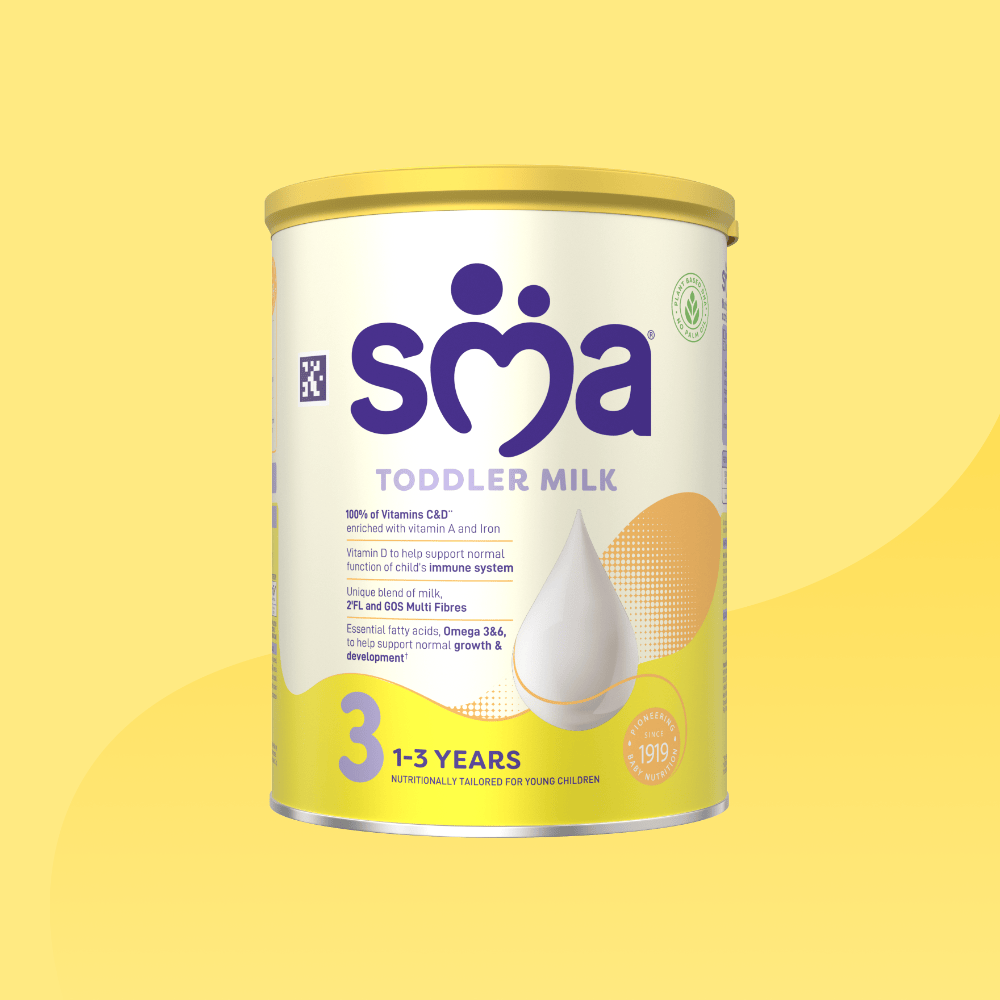SMA® Toddler Milk
A fortified milk drink suitable for young children from 1–3 years as part of a healthy balanced diet.
SMA® Toddler Milk contains 2'FL*
Data cards
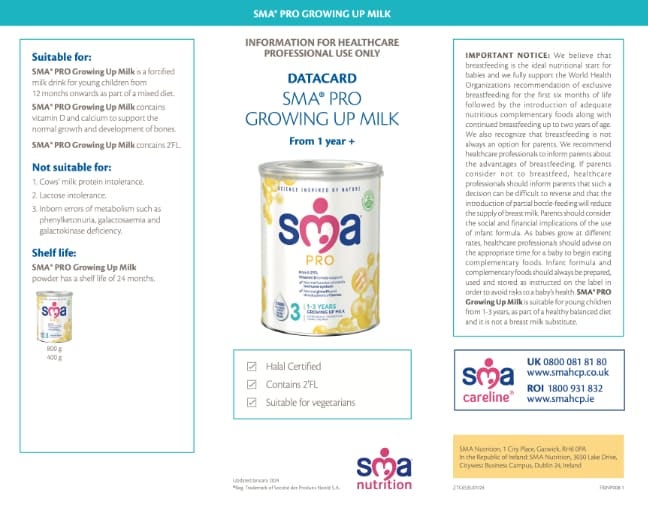
Download the powder format data card
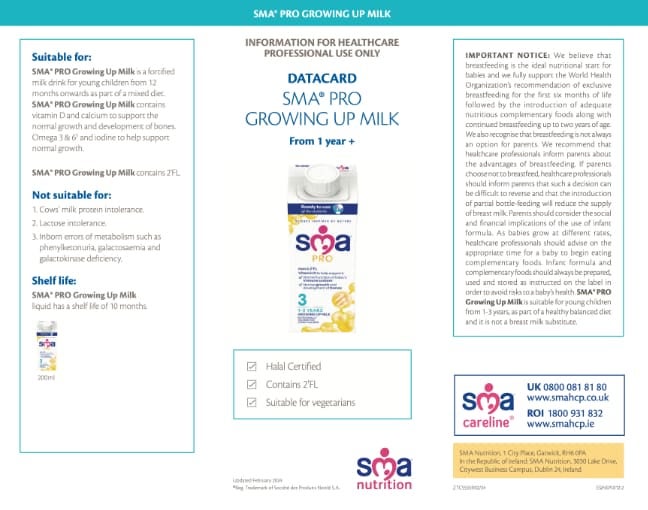
Download the liquid format data card
Product details
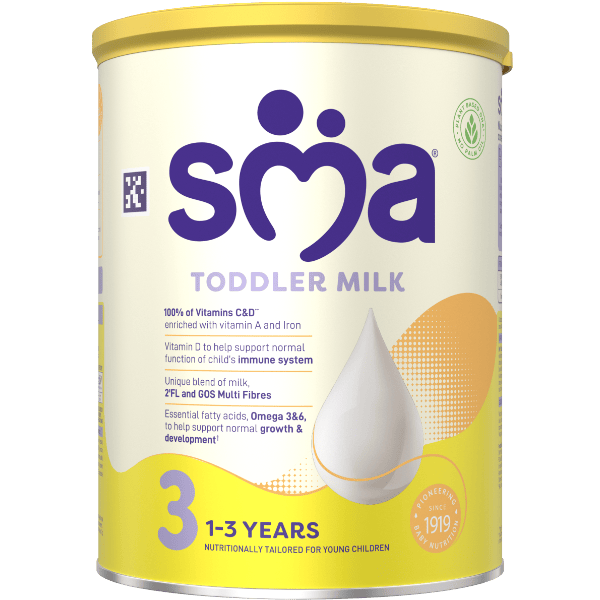
SMA® Toddler Milk Powder
800g Powder
Easy open lid. Scoop can be stored in suspension inside the can. Use product within 4 weeks of opening. Approximately 173 scoops per can. Approx. 28 x 200 ml servings per can.

SMA® Toddler Milk Powder
400g Powder
Easy open lid. Use product within 4 weeks of opening. Approximately 86 scoops per can.
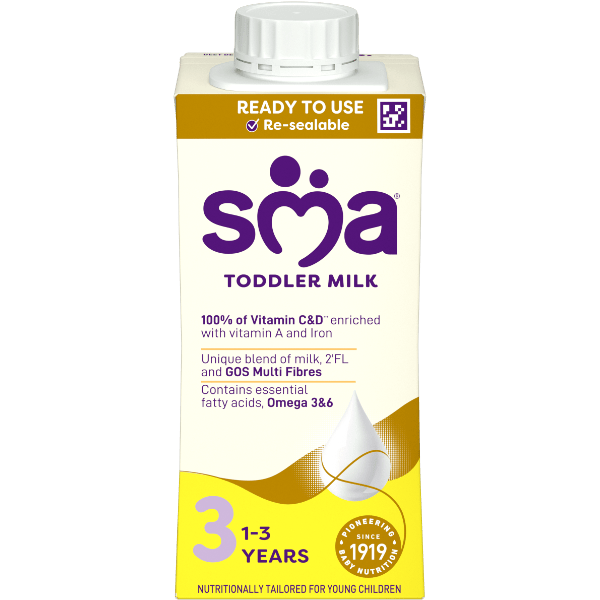
SMA® Toddler Milk Ready to Drink
200ml Resealable Carton
Ready to use liquids do not require any preparation, just shake and pour into a clean beaker. 200 ml on-the-go resealable cartons are easy to pour and can be kept in the fridge for up to 24 hours after opening.
Feeding guide – powdered milk
| Feeding guide from 12 months to 3 years | |||
| 1 serving = 200 ml | Amount of cooled, boiled water | Level Scoops | |
| ml | fl. oz. (approx.) | ||
| 1 beaker | 180 | 6 | 6 |
6 scoops of powder added to 180 ml (6 fl. oz. approx.) water makes 200 ml (7 fl. oz. approx.) milk drink. All toddlers have different nutritional needs, but after 12 months we recommend a child has around 400 ml of milk per day. You can feed a child up to 2 servings per day depending on their individual nutritional needs. Mix 1 scoop of powder to 30 ml (approx.1 fl. oz.) of water. Approx. 173 scoops per can. 1 scoop = 4.6 g.
Approx. 28 x 200 ml servings per can (applicable to 800 g can only).
Feeding guide – liquid milk
All toddlers have different nutritional needs, but after 12 months we recommend a child has around 400 ml of milk per day. You can feed a child up to 2 servings a day depending on their individual nutritional needs.
Information for you to give to parents.
SMA® Toddler Milk powder – 800 g and 400 g can
- Do not add extra powder or water to make the drinks stronger or weaker and do not press powder into scoop. Using too much or too little powder can make your toddler ill.
- We recommend preparing each milk drink in individual beakers when required.
- For hygienic reasons, discard unfinished feed in the beaker as soon as possible.
- Made-up milk drink can be poured over cereals and mixed with food.
- Do not alter or add to milk drink unless medically directed.
- Do not warm feeds in a microwave – hot spots may occur and cause scalding.
SMA® Toddler Milk liquid – 200 ml Tetra-Pak®
- Check best before date.
- Shake carton well before use.
- Once open, store only in the fridge (5 ºC or below) for up to 24 hours in the carton, with the corners turned down.
- For hygienic reasons, discard unfinished feed as soon as possible, and always within 1 hour.
- Do not warm in a microwave, hot spots may occur and cause scalding.
- Do not freeze.
Preparation
Information for you to give to parents
How to prepare the toddler's drink – powder (800 g and 400 g)
While this product is made under strict hygienic conditions, it is not sterile. Failure to follow instructions on preparation and storage may make the toddler ill.
Preparing the Toddler's drink – 200 ml liquid
Failure to follow instructions on preparation and storage may make the toddler ill.
- SMA® PRO Growing up milk data card.
- Aptamil datacard for Growing up milk. Available at: https://www.nutricia.co.uk/hcp/products.html (accessed February 2021)
- Aptamil Profutura datacard for Growing up milk. Available at: https://www.nutricia.co.uk/hcp/products.html (accessed February 2021)
- Cow and Gate datacard for Growing up Milk. Available at: https://www.nutricia.co.uk/hcp/products.html (accessed February 2021
- HIPP datacard for Growing up Milk. Available at: https://www.hipp4hcps.co.uk/fileadmin/media_hcp/pdf/HiPP_growing_up_milk_600g_220819_final.pdf (accessed February 2021)
- Baird et al., Being big or growing fast: systematic review of size and growth in infancy and later obesity. BMJ, doi:10.1136/bmj.38586.411273.EO after rapid growth.
- Weber et al., Lower protein content in infant formula reduces BMI and obesity risk at school age: follow-up of a randomized trial. Am J Clin Nutr 2014;99:1041–51 for higher risk of obesity
- Scientific Opinion on the substantiation of a health claim related to Vitamin D and contribution to the normal function of the immune system pursuant to Article 14 of Regulation (EC) No. 1924/2006. EFSA Journal 2015; 13(5);4906
- Goehring KC et al. Similar to Those Who Are Breastfed, Infants Fed a Formula Containing 2’- Fucosyllactose Have Lower Inflammatory Cytokines in a Randomized Controlled Trial J Nutr. 2016;146:2559–2566.
- Vandenplas et al., Human Milk Oligosaccharides: 2-Fucosyllactose (2-FL) and Lacto-N-Neotetraose (LNnT) in Infant Formula. Nutrients 2018, 10, 1161;
- Pimpin L, Jebb S, Johnson L, Wardle J, Ambrosini GL. Dietary protein intake is associated with body mass index and weight up to 5 y of age in a prospective cohort of twins. Am J Clin Nutr. 2016;103:389-97.
- Sidnell A et al. Nutrient intakes and iron and vitamin D status differ depending on main milk consumed by UK children aged 12-18 months-secondary analysis from the Diet and Nutrition Survey of Infants and Young Children. J Nutr Sci 2016;5 (32):1-8.
- Hojsak I, et al. Young Child Formula: A position paper by the ESPGHAN Committee on Nutrition. JPGN 2018, Jan;66(1):177-185.
- Gibson S & Sidnell A. Nutrient adequacy and imbalance among young children aged 1–3 years in the UK. Nutrition Bulletin 2014; 39: 172–80.
- Domellöf M et al. Iron requirements of infants and toddlers. J Pediatr Gastroenterol Nutr 2014; 58: 119–29.
- Bode L. Human milk oligosaccharides: every baby needs a sugar mama. Glycobiology 2012; 22(9): 1147–62.
- Jantscher-Krenn E, Bode L. Human milk oligosaccharides and their potential bene ts for the breast-fed neonate. Minerva Pediatr 2012; 64(1): 83–99.
*2'FL: structurally identical human milk oligosaccharides, not sourced from breast milk
IMPORTANT NOTICE:
The World Health Organisation (WHO) recommends exclusive breastfeeding during the first 6 months of life and continued breastfeeding for as long as possible. SMA® Toddler Milk is suitable for young children from 1–3 years, as part of a healthy balanced diet and it is not a breast milk substitute.

